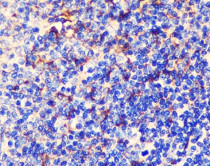ARG43325
anti-CD137 antibody
anti-CD137 antibody for IHC-Formalin-fixed paraffin-embedded sections,Western blot and Human,Mouse,Rat
Overview
| Product Description | Rabbit Polyclonal antibody recognizes CD137 |
|---|---|
| Tested Reactivity | Hu, Ms, Rat |
| Tested Application | IHC-P, WB |
| Host | Rabbit |
| Clonality | Polyclonal |
| Isotype | IgG |
| Target Name | CD137 |
| Antigen Species | Human |
| Immunogen | Synthetic peptide within aa. 150-250 of Human CD137 (NP_001552.2). |
| Conjugation | Un-conjugated |
| Alternate Names | ILA; CD137; T-cell antigen 4-1BB homolog; CDw137; T-cell antigen ILA; 4-1BB; CD antigen CD137; Tumor necrosis factor receptor superfamily member 9; 4-1BB ligand receptor |
Application Instructions
| Application Suggestion |
|
||||||
|---|---|---|---|---|---|---|---|
| Application Note | * The dilutions indicate recommended starting dilutions and the optimal dilutions or concentrations should be determined by the scientist. | ||||||
| Positive Control | Mouse spleen | ||||||
| Observed Size | ~ 28 kDa |
Properties
| Form | Liquid |
|---|---|
| Purification | Affinity purified. |
| Buffer | PBS (pH 7.3), 0.02% Sodium azide and 50% Glycerol. |
| Preservative | 0.02% Sodium azide |
| Stabilizer | 50% Glycerol |
| Storage Instruction | For continuous use, store undiluted antibody at 2-8°C for up to a week. For long-term storage, aliquot and store at -20°C. Storage in frost free freezers is not recommended. Avoid repeated freeze/thaw cycles. Suggest spin the vial prior to opening. The antibody solution should be gently mixed before use. |
| Note | For laboratory research only, not for drug, diagnostic or other use. |
Bioinformation
| Database Links |
Swiss-port # P20334 Mouse Tumor necrosis factor receptor superfamily member 9 Swiss-port # Q07011 Human Tumor necrosis factor receptor superfamily member 9 |
|---|---|
| Gene Symbol | TNFRSF9 |
| Gene Full Name | tumor necrosis factor receptor superfamily, member 9 |
| Background | The protein encoded by this gene is a member of the TNF-receptor superfamily. This receptor contributes to the clonal expansion, survival, and development of T cells. It can also induce proliferation in peripheral monocytes, enhance T cell apoptosis induced by TCR/CD3 triggered activation, and regulate CD28 co-stimulation to promote Th1 cell responses. The expression of this receptor is induced by lymphocyte activation. TRAF adaptor proteins have been shown to bind to this receptor and transduce the signals leading to activation of NF-kappaB. [provided by RefSeq, Jul 2008] |
| Function | Receptor for TNFSF9/4-1BBL. Possibly active during T cell activation. [UniProt] |
| Cellular Localization | Membrane; Single-pass type I membrane protein. [UniProt] |
| Calculated MW | 28 kDa |
Images (2) Click the Picture to Zoom In
-
ARG43325 anti-CD137 antibody IHC-P image
Immunohistochemistry: Paraffin-embedded Rat spleen tissue stained with ARG43325 anti-CD137 antibody at 1:100 dilution.
-
ARG43325 anti-CD137 antibody WB image
Western blot: 25 µg of Mouse spleen lysate stained with ARG43325 anti-CD137 antibody at 1:1000 dilution.







